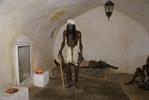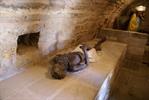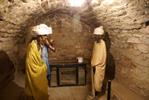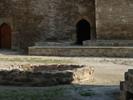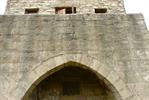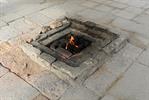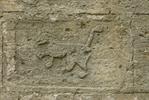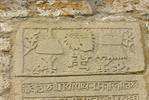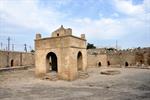The first place on most people's agenda is the town of Surakhani. The town itself is nothing spectacular but it's a 17th century temple which has acted like a beacon through the years. However the sight has been holy for much longer than that.
The unique Ateshgah Fire Temple (10am-6pm) is one of Azerbaijan's most remarkable sights. Don't expect too much from this place, but as long as you go with "realistic" expectations, you can't be disappointed. Situated in the middle of an urban sprawl, right next to some train tracks and fields and fields of oil derricks, you will find the Ateshgah fire temple.
It stands on the site of a natural gas vent that was sacred to Zoroastrians for centuries, though this temple was actually built by 18th-century Indian Shiva devotees. They lived in the surrounding pentagonal caravanserai and performed extreme ascetic practices such as lying on hot coals or carrying unbearably heavy chains. Such eccentric behaviour is depicted by a number of mannequins in the museum section. The grounds are small and self-contained. There are several rooms within the fortified walls, with tacky mannequin displays and a few pictures (some even with English). The walls themselves are covered with numerous plaques in Sanskrit and Punjabi.
But the temple's centrepiece is the flaming stone hearth with four stone side flues that also spit dragon breath. At least when the caretaker bothers to turn on the gas. The original natural vent has long been exhausted, so today the flame comes courtesy of Baku's main gas supply.
According to historical sources, before the construction of the Indian Temple Of Fire in Surakhani at the end of the 17th, the local people also worshiped at this site because of the "seven holes with burning flame". These "seven holes with burning flame" are the literal meaning of the toponym "Surakhani". Zoroastrians, an ancient fire worshiping religion considered the natural gas vents as a pinnacle of their ceremonies. This 3,000 year old religion was quite prevalent within the region, stretching from China to Europe, but having it's heartland around Persia. However, once the Hindu's moved in and built the temple we see today, the area lost any and all traces to Zoroastrianism. Experts from early explorers to modern historians were unaware of it's true history until excavations could be undertaken. To make matters even worse, with the encroaching settlement of the town, increased gas production and diversion of the main gas field to factories nearby, the original flame extinguished in 1969. Today, the museum's fire is fed by mains gas piped in from Baku city. If you arrive early, you can even help light the fires... with a match!
From Baku take the cruddy old elektrichka, marshrutka 84 from Narimanov metro station or less direct marshrutka 231 from Qara Qarayev metro via the intriguing town of Amircan. From Mardakan take marshrutka 77. All of the above stop near Suraxany train station. From the south side of the station, walk southeast parallel to the rail tracks for three minutes, then curve right to find the Atesgah's entrance just beyond. There are some intriguingly decrepit old oilfields nearby.
If you're planning a trip to Azerbaijan you may be interested ▶ Azerbaijan highlights - For those who prefer to go unbeaten path, to explore less visited places and check national charisma of this small country in Southern Caucasus on the edge of Europe.








